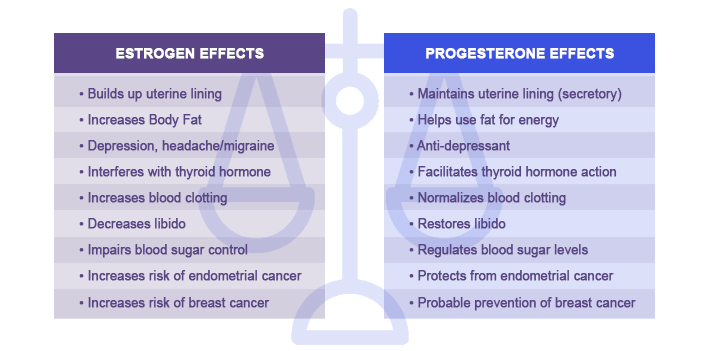Estrogen Dominance
Estrogen dominance is a condition where estrogen is high in relation to progesterone. It doesn’t necessarily mean that estrogen is elevated (although often it is) – it means that there is not enough progesterone production to oppose estrogen and keep it in check.

Most hormone imbalances are connected to either an excess of estrogen or estrogen that isn’t balanced or isn’t opposed with enough progesterone. This hormone imbalance was termed Estrogen Dominance by Dr. John R Lee.
Even women with low estrogen levels can be estrogen dominant due to a deficiency of progesterone.
Symptoms of Estrogen Dominance
Estrogen Dominance produces a wide range of symptoms:
- Acceleration of the again process
- Allergies, including asthma, hives, rashes, sinus congestion
- Anxiety often with depression
- Autoimmune disorders such as lupus erythematosus and Hashimoto’s thyroiditis and possibly Sjogren’s syndrome (dry mouth)
- Breast Cancer
- Breast Tenderness
- Cold hands and feet as a symptom of thyroid dysfunction
- Copper excess and zinc deficiency
- Decreased sec drive
- Depression with anxiety or agitation
- Dry Eyes
- Early onset of menstruation
- Endometrial (uterine) Cancer
- Fat gain, especially around the hips and thighs
- Fatigue
- Fibrocystic breasts
- Gallbladder disease
- Headaches
- Hypoglycemia
- Increased blood clotting (increasing the risk for strokes)
- Infertility
- Irregular menstrual periods
- Irritability
- Insomnia
- Magnesium deficiency
- Mood Swings
- Osteoporosis
- Polycystic Ovaries
- Premenopausal bone loss
- PMS
- Prostate Cancer
- Sluggish metabolism
- Thyroid dysfunction mimicking hypothyroidism
- Uterine Cancer
- Uterine Fibroids
- Water Retention and Bloating
Cause of Estrogen Dominance at All Ages
There is a misconception that the symptoms of menopause are normal. They may be common, but they’re not normal. Today, women are experiencing eight to ten years (or more), of life-disrupting perimenopausal symptoms.

Teens
Lack of regular ovulation and low progesterone

Premenopause
20-30% higher Estrogen Levels widely fluctuating

Perimenopause
Low progesterone Menopause

Menopause
Low Progesterone often with elevated Testosterone
It wasn’t meant to be this way. We were meant to see some mild symptoms leading up to menopause; menopause is technically one year without a period. Perimenopause, which wasn’t even a term until about 15 or so years ago, should only last about a year or maybe two, and again, should be mild.
Hot flashes, flushing, weight gain, unstable moods, brain fog, and heavy periods are signs of Estrogen Dominance.

“Without progesterone Estrogen becomes a significant factor in the promotion of cancer”
What your Doctor may not tell you about Breast Cancer…
JR Lee
The best way to diagnose Estrogen Dominance is with a saliva test which determines the levels of estrogen, progesterone and testosterone which are actually available to cells.
